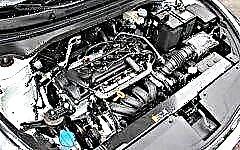

The content of the article:
- Features of car restoration
- Stages of work
Car restoration is a great opportunity to get an original copy, as well as a good idea for a business. Just think how prestigious it is to ride a chic retro car and how nice it is to know that it is you who breathed life into this old, rusty car. The price of refurbished cars doubles every year, which means that restoring vehicles is a great investment.
Features of car restoration

Before proceeding with the restoration of an old car, it is necessary to study the features of the procedure, plan the stages of work, calculate the necessary financial and time costs.
Since the restoration of machines is a serious matter, there is no rush in this matter. So, what activities need to be carried out before starting directly to work:
- We choose a car that we will restore, evaluate it and study the features and completeness.
- We collect the necessary information, look for literature on the operation and repair of this model, and also study the reviews and advice of the owners.
- We are writing an approximate list of parts, assemblies, necessary paints and varnishes and lubricants that will be needed for restoration.
- We calculate the budget. You will not be able to accurately calculate the funds required for the restoration, so the amount received must be multiplied by two. What makes up the budget:
- the cost of the car;
- funds for the purchase of parts, paints, tools;
- the cost of additional services that cannot be done independently, for example, milling, turning, argon welding, etc.
- rental of premises for restoration;
- the cost of a tow truck. This point should be taken seriously so that in the future, you do not face a situation of lack of funds.
If you have completed all the preparatory activities and are ready to get down to business, keep in mind that car restoration is a very long process. If we are talking about true restoration, with a complete disassembly of the car and repair of every little thing, you will spend at least a year on it. This is at its best. But time, as well as funds, must be planned with a margin, because in the process of work you will certainly encounter unforeseen situations more than once.
Let's consider step by step the whole process of restoration of an old car.
Stages of work

Stage 1. Complete disassembly of the car
The first stage is not difficult for an experienced car enthusiast. Indeed, disassembling a car is much easier and faster than assembling and starting a newly refurbished car. However, at this stage it is important to observe the following guidelines:
- Take a photo of every detail, sign the elements and all the necessary tags. For this purpose, it is advisable to have a separate notebook - so information about the assembly will always be at hand.
- Prepare in advance a sufficient number of boxes, racks for sorting a certain group of elements. Do the work slowly and meticulously so as not to lose small parts and remember the design of the machine.
- After the car is completely disassembled, it is necessary to do the cleaning and preparation of the body parts. First of all, the remnants of paintwork and putty are removed from the metal. There are several ways to remove old paint from the body, the most convenient is mechanical. It is cleaning the body with a grinder or sandblasting equipment. You can also use a chemical or thermal method - each of them has its advantages.
The cleaned body must be primed as the moisture in the air has a negative effect on the "bare" metal.
Stage 2. Repair and restoration of the chassis
The car frame is the most important structure, it is the place of attachment of the main units of the machine and its body. At this stage, inspection, troubleshooting and identification of chassis problems (violation of geometry, cracks) are carried out. Then malfunctions of the "skeleton" of the car are eliminated. High-quality frame repair is important, because the most important thing depends on its condition - safety.
Stage 3. Painting of body elements

Prepared primed body elements are subject to painting. Before applying the enamel, it is important to properly glue the machine and hide the parts that will not be stained.
We apply enamel to the body surface with a spray gun - this is the first, "base" layer. The enamel is applied in parallel, horizontal stripes that overlap each other by about half a centimeter.
Apply the second layer of paintwork in vertical lines. Then, in the "drying" mode, let the paint finally harden. Dry the car at a temperature of 50-80 degrees, about 50 minutes.
Stage 4. Restoration or replacement of technical units of the machine
The time it takes to complete this stage depends on the technical condition of the vehicle and the serviceability of the parts. In most cases, the restoration of the nodes takes almost a third of the entire work time. The difficulty lies in the fact that it is already unrealistic to find a lot of necessary spare parts on sale, so the restorer has to turn to the services of turners in order for them to recreate the necessary element.
At this stage, a thorough diagnostics of the brake system, steering, chassis, cooling system, fuel system units and their repair is carried out.
Stage 5. Overhaul of the internal combustion engine and gearbox
Restorers rarely manage to avoid this stage, since the age of the vehicle negatively affects the technical condition of the car's heart. The stage begins with a complete disassembly and troubleshooting of engine and gearbox assemblies. Then the question of how you want to restore the engine is decided.
There are two options here: to restore the original motor or to improve it, giving it new, more powerful properties. In both the first and second cases, you will have to spend time looking for the necessary components or, if they are not available on sale, order from a turner.
Sometimes the best solution is not to overhaul the motor, but to replace it. Do not forget that the engine needs to be switched to modern gasoline and run in after major intervention.
Stage 6. Electroplating (chrome plating of elements)
Almost all retro cars have a variety of chrome-plated parts that have lost their appeal over time. The restoration of such elements must begin with the removal of the old layer and thorough polishing. Then the parts are subjected to the copper plating procedure, with the help of which they achieve a perfectly flat surface. At the end of the stage, the spare part is plated with nickel and chrome.
Stage 7. Complete assembly of the vehicle
This work must be taken seriously and responsibly. This is where all the notes and photos taken at the first stage, as well as the instruction manual, will come in handy.
Stage 8. Restoration of the car interior

The amount of work involved in restoring the interior of a car depends on its original condition and the intended design. The following are considered mandatory restoration procedures:
- complete dry cleaning of the interior, removal of all stains, streaks;
- removing and cleaning upholstery and panels;
- restoration of small decorative details, as required.
It is also necessary to wash the seat covers or tighten the latter with a new fabric, leather.Updating the interior will help the restored car look chic and expensive, not only outside, but also inside.
Step 9. Completing the machine with missing parts
This includes decorative items such as ashtrays, emblems, sun visors or wheel covers. Sometimes it takes a lot of work to find the missing part, especially on vintage cars.
Stage 10. Testing a retro car and running it in

The final stage of this complex work consists in trial runs and elimination of any deficiencies found, if any. Car break-in should be long in order to check its technical condition and safety indicators. Typically, a ride lasts 500 - 1000 km.
For a complete restoration of the car, it is necessary to carry out serious and lengthy work. But after seeing and evaluating its result, you will definitely not regret the effort and time spent. Currently, the number of restorers is growing, because car restoration is not only an interesting and useful business, but also profitable.











